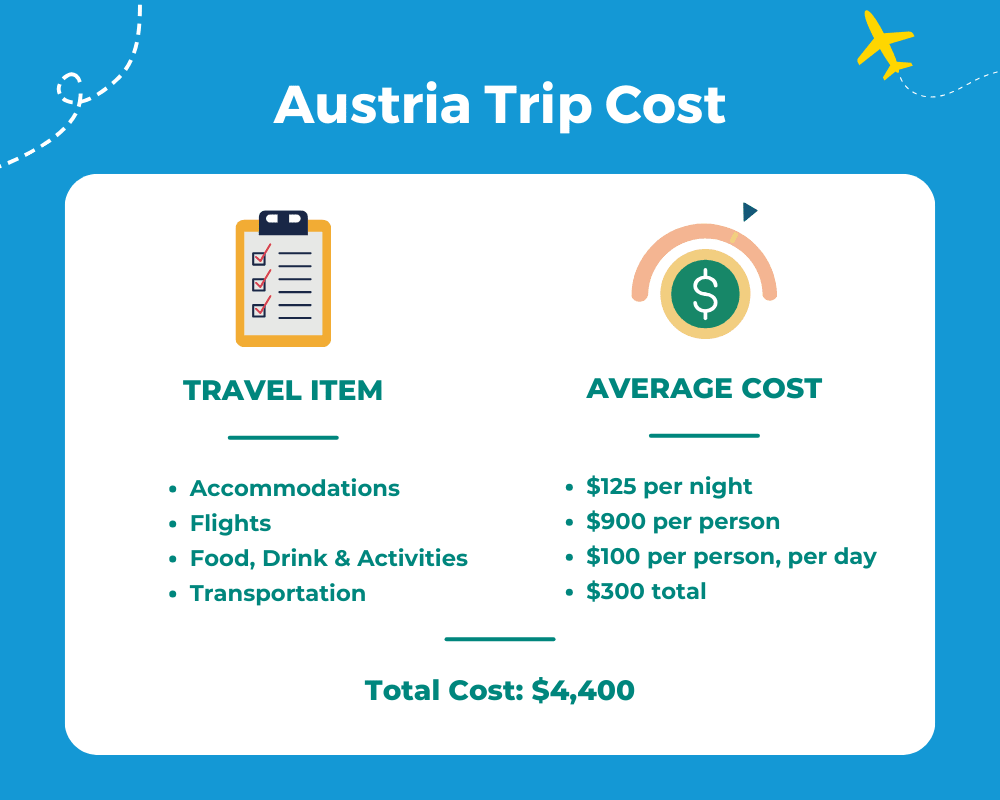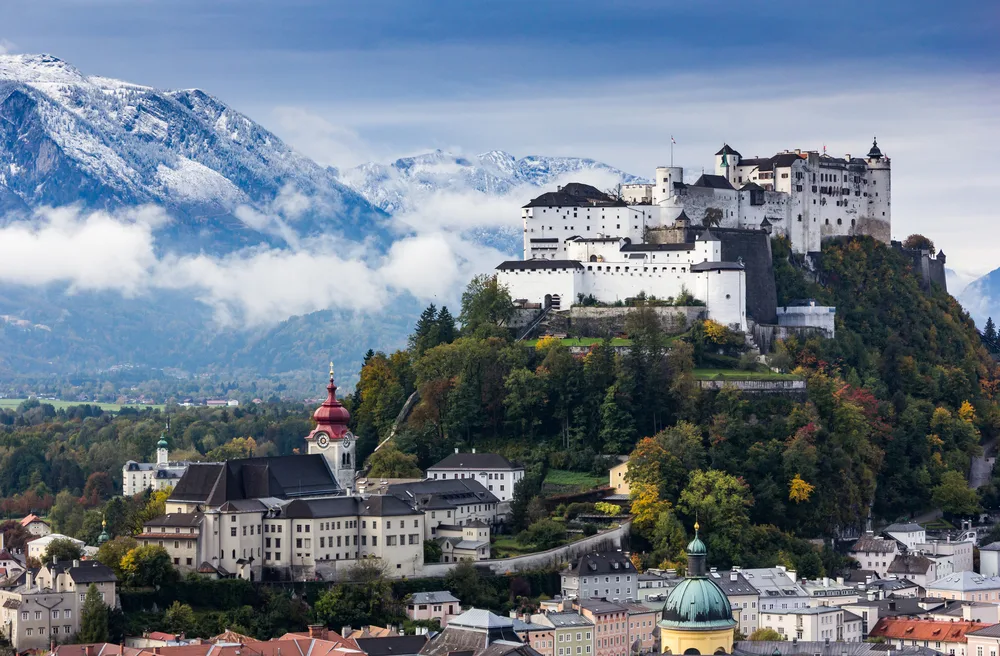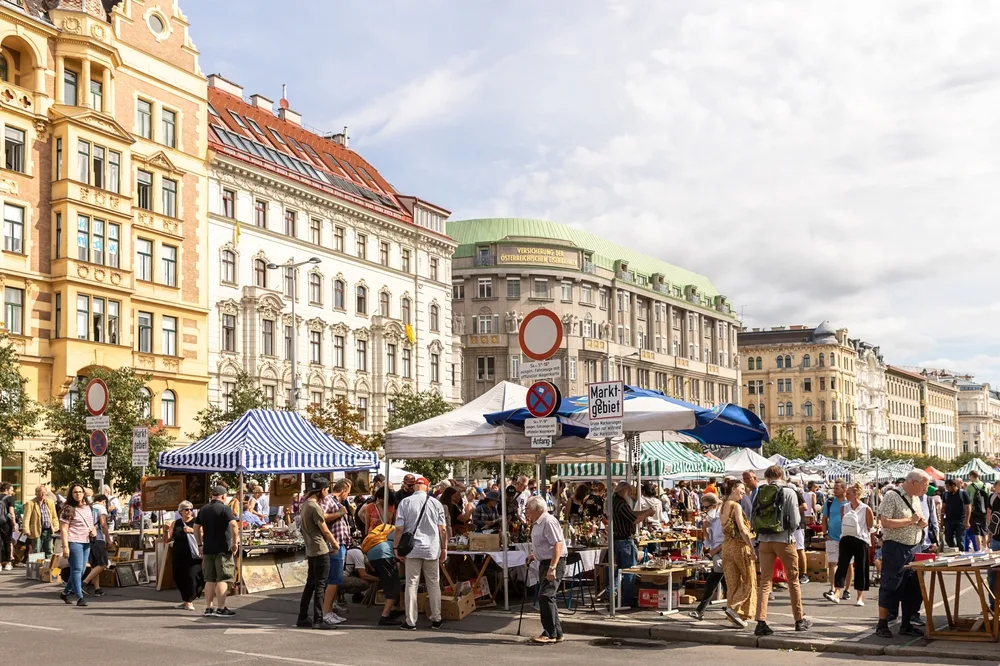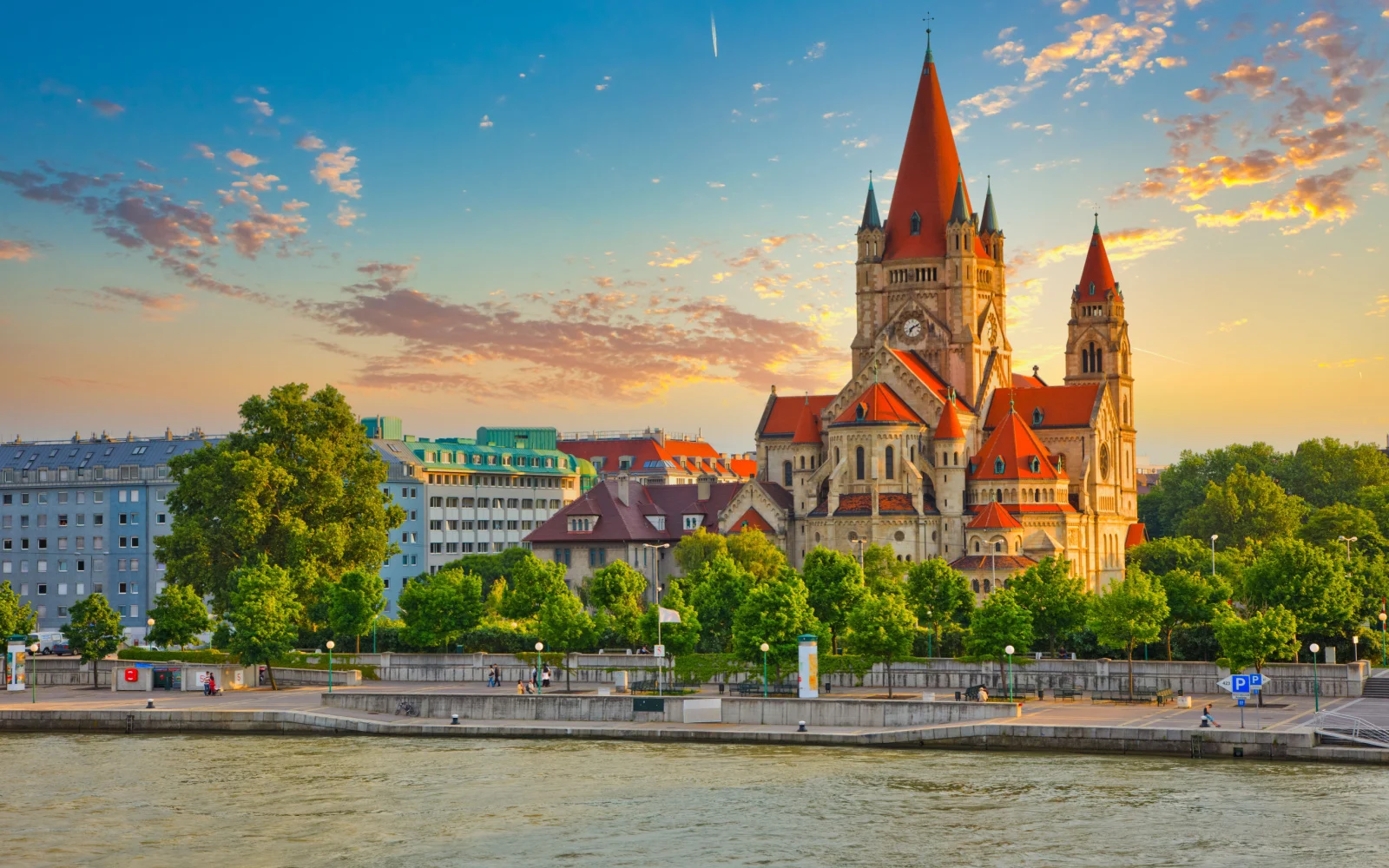First settled 10,000 years ago by hunter-gatherers who loved the look of its lush valleys, Austria has held a reputation for beauty, fine living, and enjoyment ever since.
From Celtic settlers in 400 BCE to the Romans around 200 BCE, to Bavarian, Frankish, and German rule, Austria has retained its appeal. The same is true today.
Visitors go there for the delicious food (everyone loves wiener schnitzel), the music (we all remember Beethoven, don’t we?), and the eye-popping architecture (hello, Hochosterwitz Castle).
As a European destination, however, Austria has a reputation for being costly. The truth is, though, that there are many ways to make a visit affordable.
After all, if you’re going to shell out for a trip across the world, you want to make the most of it. We’re here to help you do just that with some money-saving hacks that will help you see this beautiful, historic country for less. Read on!
Average Trip to Austria Cost in 2025

An average one-week trip to Austria for two people will cost around $4,400:
- Average Accommodation Cost: $125 per night
- Average Flight Cost: $900 per person
- Food, Drink & Activities: $100 per person, per day
- Transportation: $300 total
- Total Cost: $4,400
The cost of any trip depends on a variety of factors. Prime among these are accommodations, flights, food and drink, activities, and transportation.
Typically, these are the main areas for which you’ll want to budget, which is why we’ve included them below in detail.
If you’re traveling anywhere in Europe, check out Icelandair. They offer ticket deals for less than $1,000 that allow you to stop in Reykjavik for up to three days before moving on.
The connections aren’t as convenient – or at least it’s not guaranteed – but it’s a wonderful way to add another country to your docket if you have the time to spare.
Happily, while Austria is expensive, you won’t spend as much as many Western Europe countries – Italy, Switzerland, or France, for example. But you’ll pay more than places in Eastern Europe, Portugal, or Belgium. Let’s take a look at the best ways to save.
Austria Trip Cost: Average by Item

Vadym Lavra/Shutterstock
You can use these numbers as a starting point for your calculations, but keep in mind that they change depending on the number of people in your party, when you travel, where you stay, and what kinds of activities you do. Still, you need a place to start!
Accommodation Costs
The most popular cities to visit in Austria include Vienna, Salzburg, and Innsbruck. These cities will run you about the same per night, around $125 per night for two people.
If you’re willing to stay in a hostel or you book your accommodations for the low season, then $100 is a more reasonable budget. Going to Austria during the low season is one of the best strategies for keeping our costs low.
Summer is the busiest time, so you’ll pay more for hotels, Airbnbs, and activities then. The holidays are also a popular time to travel, when Austria’s various fairytale villages come to life.
However, spring and fall are quite affordable, with a nice balance of sun and cool temps to boot. Another way to save money on where you stay is to search for hotels in incognito mode.
This allows you to avoid saving cookies in your search engine, which will tell the algorithm that you’re interested and cause it to jack up prices in future. Lastly, you can save money on hotels and other lodging if you stay in smaller cities.
The bigger destinations will upcharge you for a place to put your head, while it’s easier to get good deals in places such as Bad Gastein, St. Gilgen, or Zell am See.
Do note that these places all have amazing resorts on offer, so don’t get confused and think those are the only options price-wise!
In general, if you budget $125 a night in Austria, you’ll have the freedom to book a hotel in big cities and small fairytale towns. If you want more wiggle room for other categories – food or adventure, say – or you want to travel on a dime, then you can pare this down.
Flight Costs
A round-trip flight from New York City to Vienna will typically cost about $700, while traveling from LA is more like $900. Online prices vary rather dramatically for Austrian travel, so make sure to do plenty of research ahead of time on airlines and watch ticket prices.
Typically in our guides, we recommend searching in incognito mode to avoid cookies that tell travel companies to hike prices on your next visit. However, in this case, it’s smarter to set price alerts on flights.
While this might mean a slightly higher cost due to cookies, the expense of a flight to Austria makes it worth it to locate deals. Overall, plan to spend an average of $900 per flight from the US, including short hops from your local airport to hubs.
Food, Drink & Activity Costs

Eva Bocek/Shutterstock
Lunch and dinner will cost between $15 and $20 at an average restaurant in Austria. Street food will cost less, while fine dining will cost more. Even that isn’t exorbitant, though: a three-course meal for two will only cost about $65.
Beer, both imported and domestic, is about $5 a pour. Ideally, you can stay in a hotel that offers a free continental breakfast, which many in Austria do for affordable rates.
All told, plan on spending about $40 per person on daily meals. Activities are also affordable if you plan ahead and focus on the ones you care about most. For instance, the Tirol cable cars are a must-visit for anyone who’s in the Innsbruck area.
This amazing network of dozens of gondolas will take you high into the Alps to a variety of destinations, including restaurants, adventure courses, viewpoints, cultural centers, hikes, ice caves, and more.
The cost varies depending on the destination, but plan to pay about $60 for a round trip and $40 for one way. You can choose to hike the other way in summer or ski the other way in winter.
Castles are another great and affordable activity. Entrance tickets are usually less than $15 for Austria’s amazing variety of castles and palaces, so if you’re the self-guided type, this is a great option.
If you want a real tour, opt for a package.
For about $125, you can get 5 hours of entertainment: a tour, a splendid meal, and a concert at Schönbrunn Palace, for example. If you’re smart about your food and activities budget, you can get by on about $100 per person, per day.
Transportation Costs
There are many ways to get around in Austria. Public transportation is affordable and reliable. Its prices vary from city to city, but typically it is around $3 for a single fare – less if you’re a child, senior citizen, or dog(!!!).
You can get a day pass for only about double the rate. You must purchase your tickets in advance. Note that while your ticket often won’t be checked at the entrance to public transit, the penalty for riding without a ticket is high. Don’t do it!
Biking is also popular, with extremely bike-friendly cities that allow you to get around quickly and see tons of architecture and other attractions while doing it.
You can even rent bikes easily in many of the cities. Typically you’ll pay between $15 and $20 a day. If you choose to rent a car to get to the surrounding countryside (also quite accessible via train and bus), plan to spend about $40 a day, on average, for a medium-sized car.
Assuming you only rent a car for a few days, take a taxi from the airport to your hotel, and use public transportation or bike a lot of the time, you can safely budget $300 total.
Things to Consider

Kanuman/Shutterstock
Here are a few other things to consider when planning your trip to Austria:
- Austria requires two pages for your entry stamp. If your passport has less than two pages available, you must replace it before visiting Austria. In general, it’s always a good idea to replace your passport if it has less than 6 months. Make sure to budget time to get it. The typical turnaround is 8-11 weeks and the expedited timeframe ($60 more) is 5 weeks. You can only get a same-day passport in the case of a medical emergency, so take these timelines seriously.
- Austria boasts a raft of gorgeous castles, most of them right out of fairytale. Built into high hills with incredible views of the surrounding countryside, the “hundreds of castles and palaces promise time travel to the chivalrous Middle Ages, the Renaissance, or the splendid Baroque era, blurring the lines between past and present.” Seriously, hundreds!
- The world’s biggest ice cave is located in Werfen, Austria. This incredible structure is straight out of the Paleolithic and offers visitors the opportunity to stroll through a kilometer of breathtaking frozen structures. It’s definitely worth a place on your itinerary, and Werfen is an adorable town to boot. It’s also located within day-tripping distance of Salzburg if you’d rather stay there.
- The summer cable cars in Tirol are boatloads of fun. We highly suggest putting those on your itinerary as well.
Frequently Asked Questions

Vienna, Austria – 20.08.2022: Flea market at the Naschmarkt in Vienna/MariaMaslova/Shutterstock
Here are some frequently asked questions about budgeting your trip to Austria:
What language do they speak in Austria?
The official language of Austria is German, and it’s the most widely spoken language as well. Unofficial and less common languages include Alemannic and Austro-Bavarian.
English is widely spoken throughout the country, however, so you probably don’t need to rely overly heavily on Google Translate. However, there are times you’ll find yourself out in the countryside or other remote places, in which case a command of German may be helpful.
Make sure you have a good data package or go old school and bring a simple phrasebook for travelers.
Will I need a visa to travel there?
You will not need a visa to travel to Austria for a week. Any amount of time less than 90 days is allowed with just a passport in hand. If you wish to stay more than 90 days in any 180-day period, however, you’ll need a Schengen visa.
“The Schengen visa is the most common visa for Europe,” explains its website. “It enables its holder to enter, freely travel within, and leave the Schengen zone from any of the Schengen member countries. There are no border controls within the Schengen Zone.”
Note that if you’re planning to stay longer (i.e. more than 90 days) in any one country for work or school, you’ll need a visa from that country.
Is Austria expensive?
Austria is about average for a European country. Take a look at the average prices for food and other amenities to get an idea of how much you’ll pay daily. An inexpensive meal out will cost about $15, while a nice meal is $30.
Produce is quite affordable at the grocery store, while you’ll pay similar costs to America on milk, eggs, bread, and cheese. (But oh, the cheese!)
Can I use dollars?
No, you cannot use dollars in Austria. However, it’s easy to exchange them all over Austria, and major credit cards are accepted at a huge number of shops, restaurants, hotels, and other proprietors throughout the country.
Do I need to rent a car?
You do not need to rent a car in Austria. Public transportation is great both inside and between cities, and it’s affordable as well.
However, if you enjoy hiking or tootling around small villages, a car rental might be the right choice. Plan to spend about $40 per day, on average.
If you’re staying near an airport (in a big city, typically), then it’s easy to rent a car for just a few days to see the surrounding countryside. You can also get there by tour, though, which might make it easier.
Wrapping It Up: Over to You!
| 🛎️ Average Accommodation Cost | $125 per night |
| ✈️ Average Flight Cost | $900 per person |
| 🍽️ Food, Drink & Activities | $100 per person, per day |
| 🚕 Transportation | $300 total |
| 💲 Total Cost | $4,400 |
The average cost of a one-week trip to Austria is around $4,400 for two people. While that’s not cheap, it’s fairly affordable for a continental vacation, so use the money-saving tips above and go for it!



